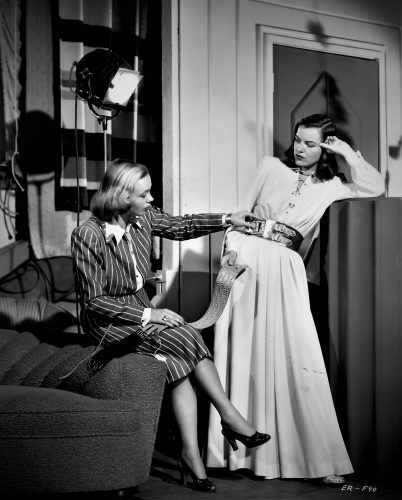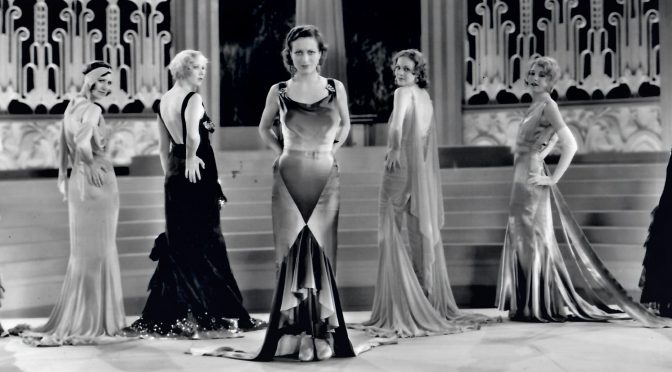Designing Hollywood: Studio Wardrobe in the Golden Age is my new book published by the University Press of Kentucky. It grew out of several of my blog posts over the last few years covering the Hollywood studio’s wardrobe departments, their costume designers, and the movie stars they dressed. Fellow CMBA blogger Patricia Schneider first gave me the idea to develop these blogs into a book. Now after three years – from post to press with lots of hurdles in between – this coming August the work will be released.
The subject of Hollywood costume design during the “Golden Age” is one part of a continuing spectrum. My book actually covers the period from the beginning of the Hollywood studios to the end of the studio system, or from about 1912 through 1970. Costume designing is still happening today with great results, only the work is not being done within the studios. The studios and their wardrobe departments are covered here in chronological order by their start, beginning with: Universal, Fox/20th Century-Fox, Paramount, Warner Bros., M-G-M, Columbia, and RKO. Within each of their chapters is covered the studio’s history in brief, the costume designers that worked there and the stars they dressed – and in many cases created the images for, and the important films that were produced. The films within the chapters are described chronologically.

In the earliest days of the Hollywood studios – the decade of the 1910s – actors usually came to the set in their own clothes, unless the film had a period setting. In the latter case, the studios usually rented costumes from Hollywood’s venerable Western Costume Company. But as actors became popular household names, they demanded a wardrobe commensurate with their status. And not long after that, the studios realized that the largely female audience was attracted to the fashions the stars wore on screen. Moreover, the costume designers themselves were becoming popular names, especially after studio publicity linked their names with the names of the stars they dressed, and the advice they gave to women on their own wardrobes.

Cecilia Evans appears above in Dressmaker from Paris, 1925. Paramount brought in Travis Banton from New York to design the costumes for this film and its fashion show. He became head designer not long after and created the look of glamour for Marlene Dietrich, Claudette Colbert, and Carole Lombard.

M-G-M had lured the Russian-French designer Erté to its studio in 1925 to design costumes, capitalizing on his celebrity status. Erté did not last long at M-G-M. Gilbert Adrian (Adrian) soon took over as head designer and created international fashion trends with his broad-shouldered look for Greta Garbo, Joan Crawford, and even the Wizard of Oz. Between Adrian and Travis Banton, they virtually created the look of modern glamour. Warner Bros. had George Orry-Kelly, an Australian who had been designing revue shows in New York and roomed with Cary Grant. He became Bette Davis’ regular costume designer. Walter Plunkett at RKO designed the early look for the dance gowns of Ginger Rogers. At 20th Century-Fox, William Travilla designed Marilyn Monroe’s famous dresses. Elizabeth Taylor first became a teenage idol at M-G-M with Helen Rose designing her look, as Jean Louis did for Rita Hayworth as Gilda at Columbia.

The above photo shows embroiderers working on a costume for Romeo and Juliet (1936) in the M-G-M wardrobe department. Note the hand-embroidered sleeve of the lady on the right.
In addition to the famous designers of the Golden Age, the other designers that worked in the studios are covered as well. These range from very early costume designers such as George James Hopkins who designed Theda Bara’s costumes in films like Cleopatra (1917) at Fox, or Vera West who designed the costumes for women in Dracula (1931), and for The Bride of Frankenstein (1935) at Universal, going on to less monsterly movies with a killer dress for Ava Gardner in The Killers opposite Burt Lancaster (1946). Also at Universal was designer Yvonne Wood, shown below at left, with Ella Raines for the film The Web, (1947).

Some less well-known costume designers are Renié (Conley) who started her career as a sketch artist at M-G-M in the late 1920s, designing her last movie Body Heat in 1982 and a TV mini-series in 1985 – a career almost as long as Edith Head’s. Or Edward Stevenson, who began as a sketch artist at M-G-M and later became the costume designer at First National Pictures, and Columbia’s first regular designer. He spent most of hist career at RKO where among many other films he designed costumes for Out of the Past, It’s a Wonderful Life, Suspicion, and Citizen Kane. He went on to design for Lucille Ball in her TV series I Love Lucy and The Lucy Show.. Edward Stevenson had also worked at RKO with Bernard Newman, a favorite designer of Ginger Rogers.

Designing Hollywood: Studio Wardrobe in the Golden Age also covers the workings of the artisans that fabricated all the costumes for the films, whether for the glamorous or for biblical epics, for Western films or for characters playing the poor. Many of their methods are revealed. And the behind-the-scenes- stories that bring the era to life are peppered throughout the book.

Along with the dramatic black and white star studio photographs, the book is supplemented with color photos of original costume design drawings. Below is a costume design by Helen Rose for Elizabeth Taylor for The Last Time I Saw Paris (1954).

Views: 27544


